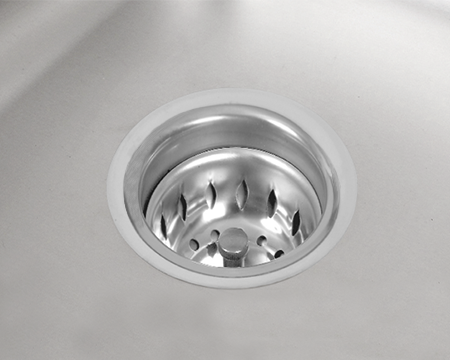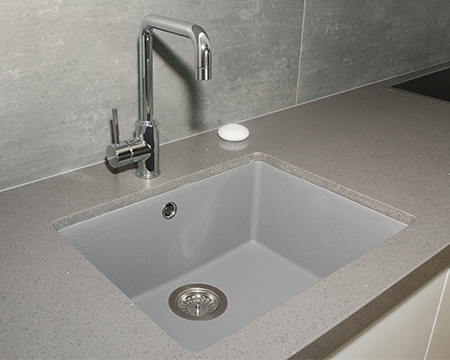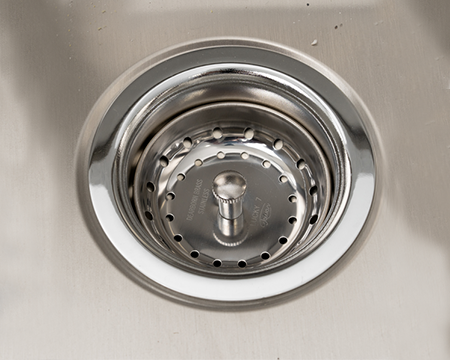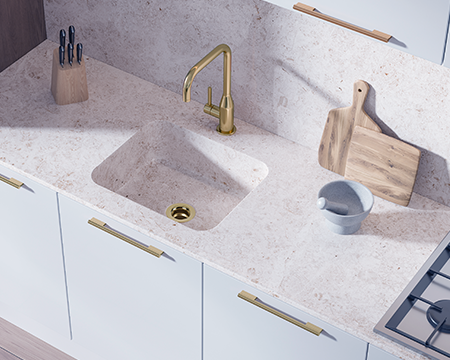The number one priority when it comes to plumbing systems is keeping the pipelines running efficiently. And sink strainers are the first line of defense against any potential blockage.
Strainers prevent clogging that can lead to system malfunction by using a mesh screen to filter out and prevent solid debris from entering the system. When water and liquids pass through a strainer, the debris basket blocks troublesome items from going down the drain, offering an easy way for scraps to be discarded.
Although there are various sink strainers, the basket option is popular for its effectiveness and affordability. Before installing or replacing one, you should consider a few variables. But let’s first look at some currently popular basket strainers.
What are the most popular sink strainer baskets?
- Double Cup Strainer: As the name indicates, this strainer consists of two cups. The bottom holder stays affixed to the drain opening, while the top can be removed for easy cleaning. The Dearborn® DB1120 Locking Cup Sink Basket Strainer provides an economical duo strainer that is not only easy to install but also easy to clean.
- Flange Strainer: A flange strainer's protective rim is connected to the sink with a rubber rim that stops water. The Dearborn® 12 Locking Cup Sink Basket Strainer offers a rubber and fiber washer to provide leak resistance, with a stainless steel basket that can easily be removed for cleaning.
- Back Nut Strainer: Affixed to the plumbing system by a back nut, a rubber seal is used to secure the space between the sink and the strainer to prevent leakage. The Dearborn® 15 Snap-N-Tite Sink Basket Strainer offers a brass back nut with a locking cup.
- Stopper Strainer: Acting as both a strainer and a stopper, this option can easily switch between both with a simple turn of a switch.
- Drain Strainer: The simplest strainer, a drain strainer, is placed on the drain to filter debris. The Dearborn® 3BN Easy Mount Sink Basket Strainer is easy to install with a triangular flange with three thumbscrews.
Like sinks, there is no one-size-fits-all sink basket strainer. Let's explore five variables to help you decide which strainer best suits your needs.

What are the key variables to consider?
1. Size and Body of Sink
Your choice of sink strainer relies heavily on your sink's drain opening and depth. The most commonly used strainers have a diameter between 3½ inches and 4½ inches. Make sure to size the strainer appropriately to prevent leaks and malfunction.
Most sink depths range between ⅛ inch to ⅜ inches. While standard strainers fit stainless steel sinks, cast iron sinks are thicker and require a strainer like the Dearborn Deep Locking Cup Sink Basket Strainer. Research product specifications to ensure the appropriate strainer is chosen for your sink style.

2. End Connection Types
End connections refer to the connection from the strainer to the tailpipe, with the most common types being flanged and threaded.
- Flanged: The most regularly used end-connection type, flanged ends are secured with nuts at the connection site, sealing the joints. A flanged washer between the two pieces prevents leaks.
- Threaded: Opposite the flanged end connection, threaded connections use grooves to screw two sections together, negating the need for multiple parts, such as nuts and washers. The least costly of the two end connections, threaded end connections are best suited for low-pressure environments.
To achieve a water-tight seal, use thread sealant like Hercules® MegaTape to ensure that any remaining voids are filled.

3. Tailpieces
Tailpieces refer to the piping section connecting to the bottom of the sink drain fitting. Similar to end-connection types, tailpieces are available in flanged or threaded options.
- Flanged: Offered with one or double flanged ends, this tailpiece uses multiple parts, such as a nut and gasket, to create a connection. Flanged tailpieces, such as the Dearborn® Double Flanged Strainer Tailpiece, are commonly used to connect a sink drain to a P-trap or S-trap.
Need more help? Our step-by-step video tutorial explains everything you need to know about installing a bathroom P-trap.
- Threaded: This tailpiece uses threads to screw different sections together and offers one or both ends for a threaded connection. As stated with end connections, utilizing thread sealants like Hercules® Pro Dope® ensures a secure, leak-proof seal.
4. Drain Stoppers
Drain stoppers play a crucial role in maintaining the functionality and cleanliness of your plumbing system. They help prevent unwanted debris from entering the pipes and causing blockages while providing an easy way to control water flow.
Drain stoppers offer various options to plug and unplug your drain setup.
- Push-Pull: To activate, push down on the stopper to close; pull up to open.
- Lift-and-Turn: Similar to the push-and-pull, turn the plug until fully sealed to activate the stopper. To release, lift and turn the stopper in the opposite direction.
- Sink Rod: Installed in the drain tailpiece, the sink rod is located behind the faucet. When pulled up, the drain stopper shifts down until it seals the drain. When pressed downwards, the sink rod lifts the plug, allowing water to drain.
- Rubber: Slightly larger in diameter than your drain, a rubber stopper creates pressure against the drain and secures it until the stopper is no longer needed. To release, pull the top of the stopper until the suction releases. The Dearborn® 10 Standard Threaded Body Sink Basket Strainer comes with a neoprene stopper with a metal post.
5. Body Material
When selecting a sink strainer, consider both affordability and functionality. With a wide range of materials available, you can find the perfect strainer to meet your needs and budget.
- ABS Plastic: Acrylonitrile Butadiene Styrene, or ABS, is a versatile thermoplastic material that thrives in high- and low-temperature environments and withstands high water pressure.
- Brass: The combination of zinc and copper creates durability and strength in this alloy metal. Brass is also resistant to rust and corrosion, which makes the Dearborn® L7 Sink Strainers the perfect choice for brass strainers. This premium strainer has a chrome-plated brass body that is corrosion-resistant.
- Stainless Steel: Known for its strength and durability, heavy-duty stainless steel offers rust and corrosion-resistant properties.

6. Finishes
When choosing a sink strainer, the finish and design can significantly impact the overall aesthetics of your kitchen or bathroom. While functionality is critical, a strainer that complements your sink and surrounding fixtures helps create a cohesive and appealing look.
Oatey sink strainers are available in various finishes — matte black, brushed nickel, polished chrome, brass, and plastic white — that will enhance any décor.
As the main entry point into your system, your strainer’s durability and productivity help maintain the health of your piping, delivering both ease of mind and cost savings. This comprehensive guide on sink basket strainer variables will assist you in selecting the optimal product for your plumbing needs, enhancing the efficiency of your entire plumbing system.
